|
The Haycraft Family
By Steven R. Butler, Ph.D.
The Haycraft Family
The Haycraft Family in London |
James Haycraft, Jr. |
Samuel Haycraft, Sr.
I am a Haycraft descendant by virtue of the marriage of my great-grandfather William Newton Jenkins to Emmerine J. Morrison, who was a daughter of Isaac Fisher Morrison, who was a son of Samuel H. Morrison, who was a son of Elizabeth (Betsey) Haycraft, who was the daughter of Samuel Haycraft, Sr., who was the son of James Haycraft, Jr., a London chimney sweep who was sentenced to transportation to America following his conviction on a charge of burglary in 1744.
The Haycraft family is English in origin and our branch has interesting history in America. James Haycraft, Jr., who settled in Virginia, came to America in 1744 as a transported convict, leaving behind a common-law wife. Upon arrival in the colonies, he was sold into indenture servitude-reportedly first to George Neville, a Virginia Planter, and then afterwards to George's son John Neville, who became a Revolutionary War general and the man who put down the Whiskey Rebellion in Pennsylvania during President George Washington's administration. In America, James Haycraft apparently married again and sired three sons, at least two of which served as soldiers on the patriot side in the American Revolution. One, Samuel Haycraft, Sr., was among the first settlers of what became Hardin County, Kentucky-birthplace of President Abraham Lincoln.
The Haycraft Family in London
According to the Patronymica Britannica: A Dictionary of the Family Names of the United Kingdom (1860), the English surname "Haycraft" is derived "from hay, and croft, a small enclosure: a place for hay ricks."1 A writer for The Cornhill Magazine concurs, remarking, "Hay in old English signifies a hedge, and Haycraft is therefore just the hedged croft or fenced enclosure."2
Although families bearing the surname Haycraft (or Haycroft as it was originally written) can be found throughout England (especially, from all appearances, in Dorset, Devon, and Berkshire), the name was also (and probably still is) commonplace throughout London, with branches in Westminster, the City, Holborn, and also on the south side of the River Thames, in Rotherhithe, Deptford, and Greenwich.
My branch of the Haycraft family is believed to be the one that resided at least since the late sixteenth century (the 1500s) in the Parish of St. Andrews, Holborn.
Antique maps of the Parish of St. Andrew's, Holborn reveal that it encompassed a relatively compact area, its boundaries roughly being present day Tottenham Court Road on the west, a line that cuts through the middle of the present-day campus of the University of London on the north, Farringdon Road on the east, and a tangle of streets on the south, some five or six blocks south of Holborn and including Lincoln's Inn (but not Lincoln's Inn Fields).
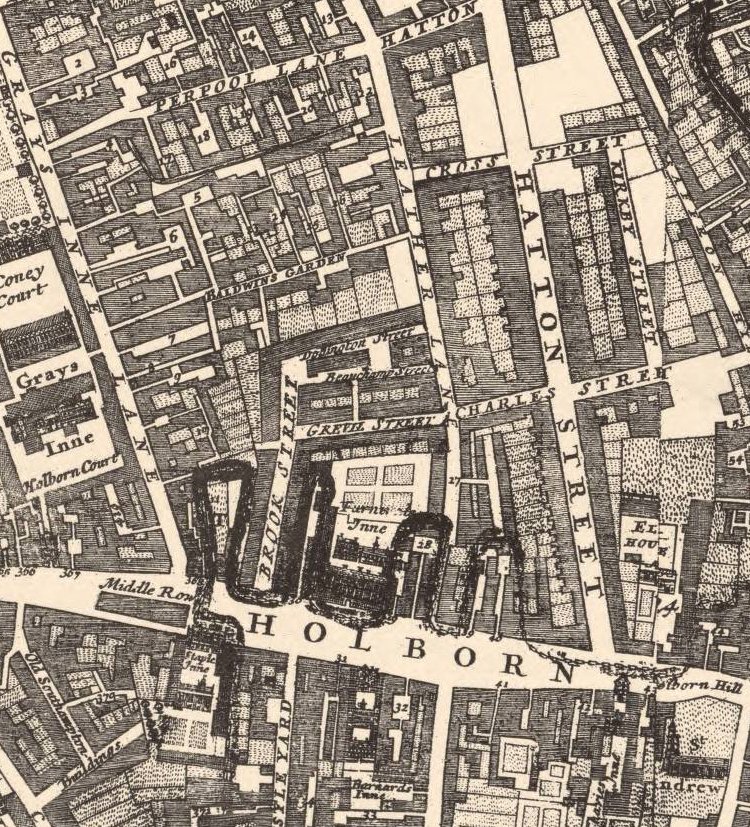
From London actually surveyed by William Morgan, 1682
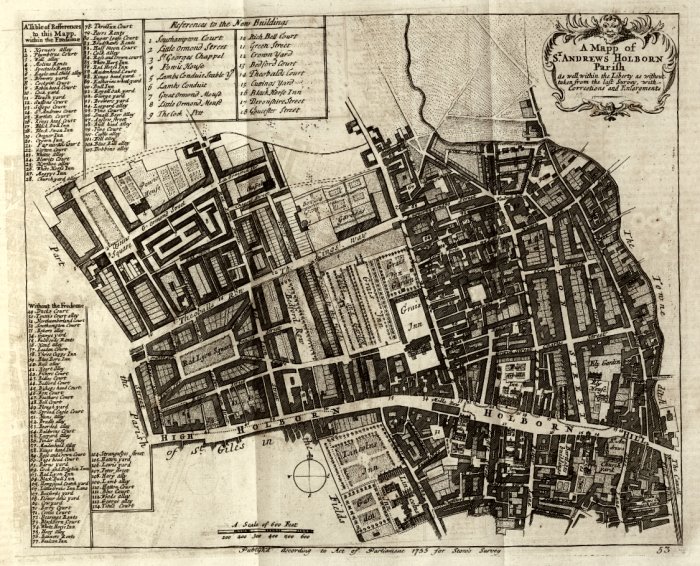
From A survey of the cities of London and Westminster, and the borough of Southwark. ... Written at first in the year 1698, by John Stow, ... Corrected, improved, and very much enlarged, in the year 1720, by John Strype, ... In two volumes. ...
Very little, unfortunately, is known about the individual members of the Haycraft family that resided in this area, apart from information we can glean from the parish registers of St. Andrew's Church, which thankfully have been preserved and digitized.
The earliest Haycraft known to have resided in this area was a man whose name was spelled Robert Hawcroft in the parish register, which records that on 28 April 1572, he married a woman with the rather odd first name of Tomison, surname Johnson.3 Whether we are descended from Robert or not is uncertain because there seems to be no further record of either him or his wife in the register.
On 26 August 1616, Elizabeth Haycraft, daughter of John Haycraft, was buried at St. Andrew's.4 On 16 September 1671, Mary Hacroft (as her name was spelled), the daughter of an obviously different John (possibly the son of the first one), was likewise buried there.5 Again, we have no way of knowing if there is any familial connection to any of these individuals.
On 22 September 1672, Thomas and Mary Haycraft took their infant daughter Mary to be christened at St. Andrew's. The record identifies Thomas as a "Joyner" and states that his daughter was born at "his house…in Hatton Yard."6 A little more than ten years later, on 8 November 1682, John and Hannah Haycroft (as it was spelled in the register) had their son James baptized at St. Andrew's. Perhaps Thomas and John were brothers? The register states further that John was a "Victualer" (a vendor or retailer of food and drink, including possibly alcoholic beverages) by trade and that the family resided at "ye sward[?] in Perpoole Lane."7 Perpoole Lane, today known as Portpool Lane, still runs east-west, just as it did in 1682, for a distance of about two or three blocks, between Gray's Inn Road and Leather Lane.
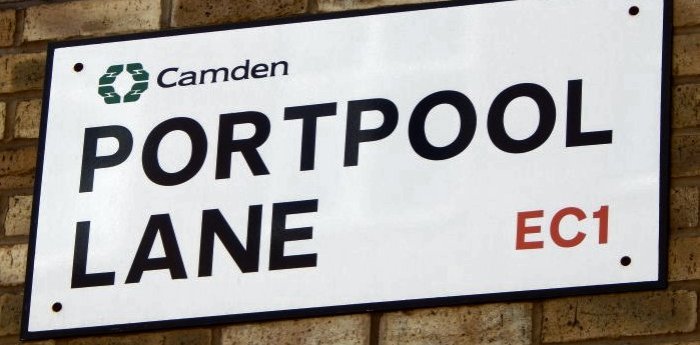
Portpool Lane sign (2016); author photo.
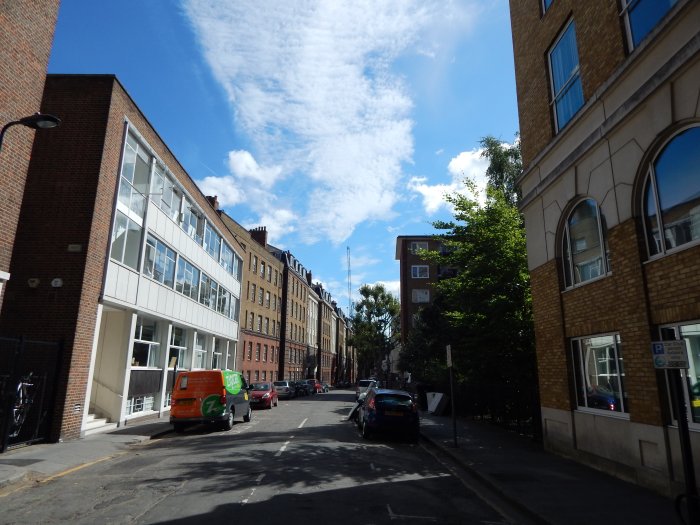
Portpool Lane, looking east from Gray's Inn Road (2016); author photo.
On 15 July 1684, Thomas Haycroft, "a child born Red Lyon," was buried at St. Andrew's.8 On 27 July 1684, not quite two weeks after Thomas was laid to rest, Hannah Haycroft "from Red Lyon" was also buried at St. Andrew's.9 Our best guess is that Thomas was Hannah's newborn son and that she died from complications following childbirth; either that or they were victims of the same unnamed illness. Unfortunately, parish registers did not generally record the cause of death.

Red Lion Street sign (2016); author photo.
Following Hannah's death, it appears that John Haycroft remarried because on 13 July 1690, a child named John Haycroft, "born on Saffron Hill," was christened at St. Andrews, with the parents listed as John and Katherine Haycroft.10 Unfortunately, the parish register records that John Haycroft "son of John Haycroft from George yard Saffron Hill" died on 14 September 1691 at the tender age of one.11

Corner of Saffron Hill and Greville Street (2016); author photo.
Nearly our years later, on 09 August 1695 the child's father John Haycroft "of Saffron Hill," was buried at St. Andrew's.12 I believe that this John Haycroft, father of both James Haycroft and John Haycroft (Jr.), was probably our ancestor.

Saffron Hill street sign (2016); author photo.
On 06 June 1712, a Martha Haycraft, relation to us (if any) unknown, was buried at St. Andrews.13
On 27 December 1719, James Haycraft, son of James Haycraft (hereinafter referred to as "James Haycraft, Sr.") and his wife Hannah, residing at "Brook's Markit" [sic], was christened at St. Andrew's.14 Most Haycraft family historians, including me, believe that this child is the same James Haycraft who was transported to America in 1744 after being convicted of burglarizing a shop in Holborn.

Here's a view of Brooke's Market, looking west (2016); author photo.

Here's the Brooke's Market street sign, attached to the above building (2016); author photo.

Here's a view of Brooke's Market, looking east (2016); author photo.
What became of James Haycraft, Sr. is unknown, nor do we know what became of his wife Hannah. There is a record of a "Mrs. Haycraft" (no first name given) being buried at Bunhill Fields, a "non-Conformist" (i.e., non-Church of England) cemetery, in 1732,15 but we cannot be sure of her complete identity or relationship to us or any of the above-named individuals.
During the later three quarters of the eighteenth century and well in the nineteenth, the surname Haycraft appears with some degree of frequency in the parish register of St. Andrew's Church. Among the first names listed are Henry, John, and Martha, as well as Walter & Mary and their children William, Thomas, and Mary, and also George & Mary and their children, Sarah, William, Elizabeth, and George. (See Record of Haycraft Family in London for complete list of individuals named in this section and the dates and circumstances of their mention in the parish register.)
Although the area where our ancestors once resided no longer looks quite the same as it did during the seventeenth and eighteenth centuries, many of the street and place names have survived to the present-day. The name "Red Lyon," now spelled "Red Lion," can be found attached to both a street and a nearby tree-filled square. Saffron Hill Street and Portpool (formerly Perpoole) Street also still exist. All of these are within short walking distance from St. Andrews Church, which likewise still exists. It can be seen standing in the same spot on Holborn (not far from the famous Holborn Viaduct) that it has occupied for centuries and is certainly worth a visit, particularly if you are a Haycraft descendant, although it is not exceptionally grand.
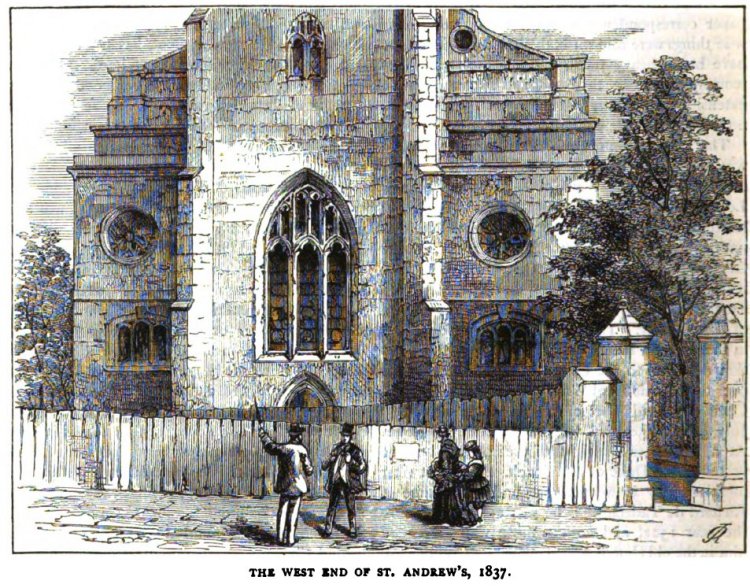
From Walter Thornbury, Old and New London: A Narrative of Its History, Its People, and Its Places (London, Paris & New York: Cassell, Petter, Galpin & Co., 1881).
The present structure "was erected...in 1686, on the site of the old church," which was probably constructed in the late thirteenth century, although there may have been a church on the site as early as the tenth century. As chance would have it, the Great Fire of 1666 spared the old church. However, because it was in such "a hopelessly ruinous condition it was taken down, with the exception of the tower, about ten years after that event, and a new building was in course of time erected in accordance with designs furnished by the great architect, Sir Christopher Wren." Two centuries later, in 1872, "St. Andrew's underwent a most thorough restoration."16
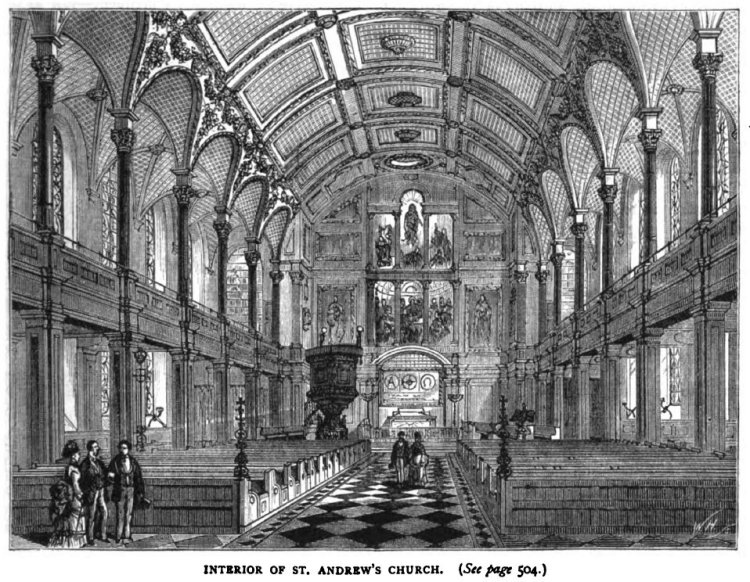
From Walter Thornbury, Old and New London: A Narrative of Its History, Its People, and Its Places (London, Paris & New York: Cassell, Petter, Galpin & Co., 1881).
Unfortunately, although the grounds and the interior of the church can be visited for free almost any day of the year, anyone looking for the burial site of their ancestors in the churchyard is bound to be disappointed. Unlike many similar churches in England, there are no tombstones surrounding St. Andrews. Part of the reason is because when the nearby Holborn Viaduct was being built in the late 1860s, Holborn was widened "through St. Andrew's Churchyard" and in carrying out this work, "a large slice of the ground was required, and this compelled the removal of a great number of human remains; between 11,000 and 12,000 were therefore decorously transferred to the City Cemetery at Ilford."17
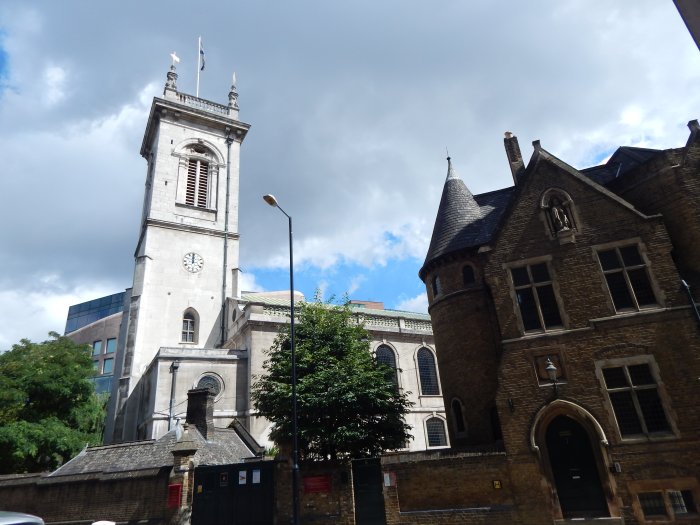
St. Andrew's Church, Holborn, looking east (2016); author photo.
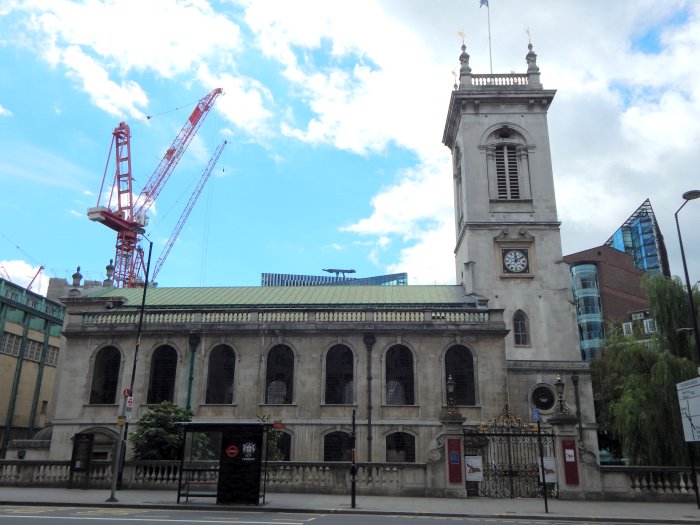
St. Andrew's Church, Holborn, looking south (2016); author photo.
Learn more about the history of St. Andrew's Holborn.
NOTES
1Mark Antony Lower, Patronymica Britannica: A Dictionary of the Family Names of the United Kingdom (London: John Russell Smith, 1860), 151.
2The Cornhill Magazine, New Series, Volume XXII, January to June 1894 (London: Smith, Elder & Co., 1894), 530.
3London Metropolitan Archives, St Andrew Holborn, Register of marriages, 1559 - 1698, P69/AND2/A/002/MS06668, Item 001.
4London Metropolitan Archives, St Andrew Holborn, Register of burials, 1558 - 1623, P69/AND2/A/010/MS06673, Item 001.
5London Metropolitan Archives, St Andrew Holborn, Register of burials, 1653 - 1672, P69/AND2/A/010/MS06673, Item 004.
6London Metropolitan Archives, St Andrew Holborn, Register of baptisms, 1654 - 1676, P82/AND2/A/001/MS06667, Item 004.
7London Metropolitan Archives, St Andrew Holborn, Register of baptisms, 1676 - 1693, P82/AND2/A/001/MS06667, Item 005.
8London Metropolitan Archives, St Andrew Holborn, Register of burials, 1672 - 1687/8, P69/AND2/A/010/MS06673, Item 005.
9London Metropolitan Archives, St Andrew Holborn, Register of burials, 1672 - 1687/8, P69/AND2/A/010/MS06673, Item 005.
10London Metropolitan Archives, St Andrew Holborn, Register of baptisms, 1676 - 1693, P82/AND2/A/001/MS06667, Item 005.
11London Metropolitan Archives, St Andrew Holborn, Register of burials, 1688 - 1698, P69/AND2/A/010/MS06673, Item 006.
12London Metropolitan Archives, St Andrew Holborn, Register of baptisms, 1693 - 1704, P82/AND2/A/001/MS06667, Item 006.
13London Metropolitan Archives, St Andrew Holborn, Register of burials, 1698 - 1715/6, P69/AND2/A/010/MS06673, Item 007.
14London Metropolitan Archives, St Andrew Holborn, Register of baptisms, 1717 - 1724, P82/AND2/A/001/MS06667, Item 008.
15The National Archives of the UK; Kew, Surrey, England; General Register Office: Registers of Births, Marriages and Deaths surrendered to the Non-parochial Registers Commissions of 1837 and 1857; Class Number: RG 4; Piece Number: 3978.
16Walter Thornbury, Old and New London: A Narrative of Its History, Its People, and Its Places (London, Paris & New York: Cassell, Petter, Galpin & Co., 1881), 503-4.
17Ibid., 502.
|